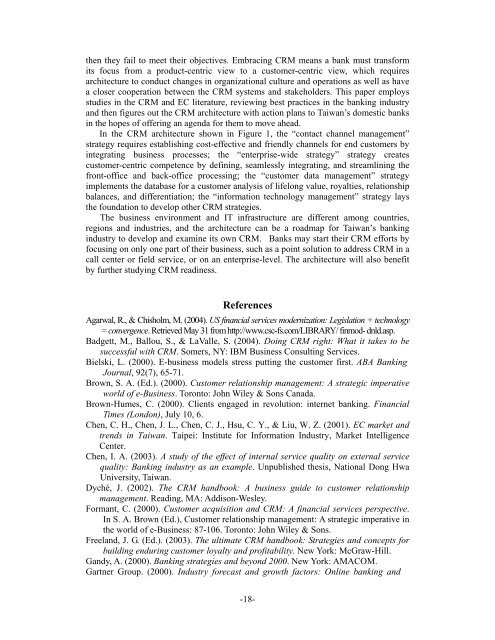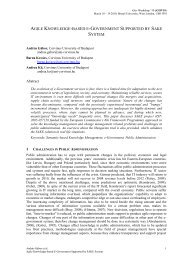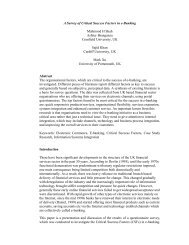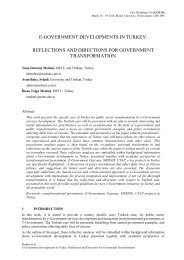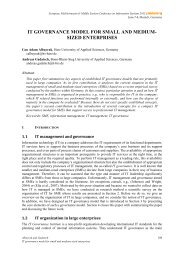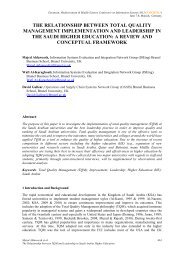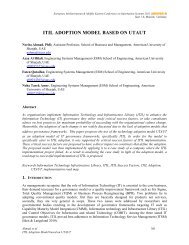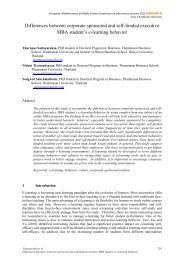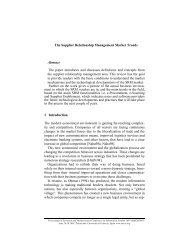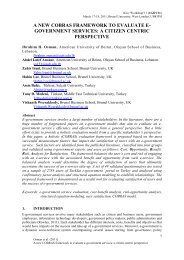Exploiting Customer Relationship Management for Taiwan's ... - ISEing
Exploiting Customer Relationship Management for Taiwan's ... - ISEing
Exploiting Customer Relationship Management for Taiwan's ... - ISEing
You also want an ePaper? Increase the reach of your titles
YUMPU automatically turns print PDFs into web optimized ePapers that Google loves.
then they fail to meet their objectives. Embracing CRM means a bank must trans<strong>for</strong>m<br />
its focus from a product-centric view to a customer-centric view, which requires<br />
architecture to conduct changes in organizational culture and operations as well as have<br />
a closer cooperation between the CRM systems and stakeholders. This paper employs<br />
studies in the CRM and EC literature, reviewing best practices in the banking industry<br />
and then figures out the CRM architecture with action plans to Taiwan’s domestic banks<br />
in the hopes of offering an agenda <strong>for</strong> them to move ahead.<br />
In the CRM architecture shown in Figure 1, the “contact channel management”<br />
strategy requires establishing cost-effective and friendly channels <strong>for</strong> end customers by<br />
integrating business processes; the “enterprise-wide strategy” strategy creates<br />
customer-centric competence by defining, seamlessly integrating, and streamlining the<br />
front-office and back-office processing; the “customer data management” strategy<br />
implements the database <strong>for</strong> a customer analysis of lifelong value, royalties, relationship<br />
balances, and differentiation; the “in<strong>for</strong>mation technology management” strategy lays<br />
the foundation to develop other CRM strategies.<br />
The business environment and IT infrastructure are different among countries,<br />
regions and industries, and the architecture can be a roadmap <strong>for</strong> Taiwan’s banking<br />
industry to develop and examine its own CRM. Banks may start their CRM ef<strong>for</strong>ts by<br />
focusing on only one part of their business, such as a point solution to address CRM in a<br />
call center or field service, or on an enterprise-level. The architecture will also benefit<br />
by further studying CRM readiness.<br />
References<br />
Agarwal, R., & Chisholm, M. (2004). US financial services modernization: Legislation + technology<br />
= convergence. Retrieved May 31 from http://www.csc-fs.com/LIBRARY/ finmod- dnld.asp.<br />
Badgett, M., Ballou, S., & LaValle, S. (2004). Doing CRM right: What it takes to be<br />
successful with CRM. Somers, NY: IBM Business Consulting Services.<br />
Bielski, L. (2000). E-business models stress putting the customer first. ABA Banking<br />
Journal, 92(7), 65-71.<br />
Brown, S. A. (Ed.). (2000). <strong>Customer</strong> relationship management: A strategic imperative<br />
world of e-Business. Toronto: John Wiley & Sons Canada.<br />
Brown-Humes, C. (2000). Clients engaged in revolution: internet banking. Financial<br />
Times (London), July 10, 6.<br />
Chen, C. H., Chen, J. L., Chen, C. J., Hsu, C. Y., & Liu, W. Z. (2001). EC market and<br />
trends in Taiwan. Taipei: Institute <strong>for</strong> In<strong>for</strong>mation Industry, Market Intelligence<br />
Center.<br />
Chen, I. A. (2003). A study of the effect of internal service quality on external service<br />
quality: Banking industry as an example. Unpublished thesis, National Dong Hwa<br />
University, Taiwan.<br />
Dyché, J. (2002). The CRM handbook: A business guide to customer relationship<br />
management. Reading, MA: Addison-Wesley.<br />
Formant, C. (2000). <strong>Customer</strong> acquisition and CRM: A financial services perspective.<br />
In S. A. Brown (Ed.), <strong>Customer</strong> relationship management: A strategic imperative in<br />
the world of e-Business: 87-106. Toronto: John Wiley & Sons.<br />
Freeland, J. G. (Ed.). (2003). The ultimate CRM handbook: Strategies and concepts <strong>for</strong><br />
building enduring customer loyalty and profitability. New York: McGraw-Hill.<br />
Gandy, A. (2000). Banking strategies and beyond 2000. New York: AMACOM.<br />
Gartner Group. (2000). Industry <strong>for</strong>ecast and growth factors: Online banking and<br />
-18


